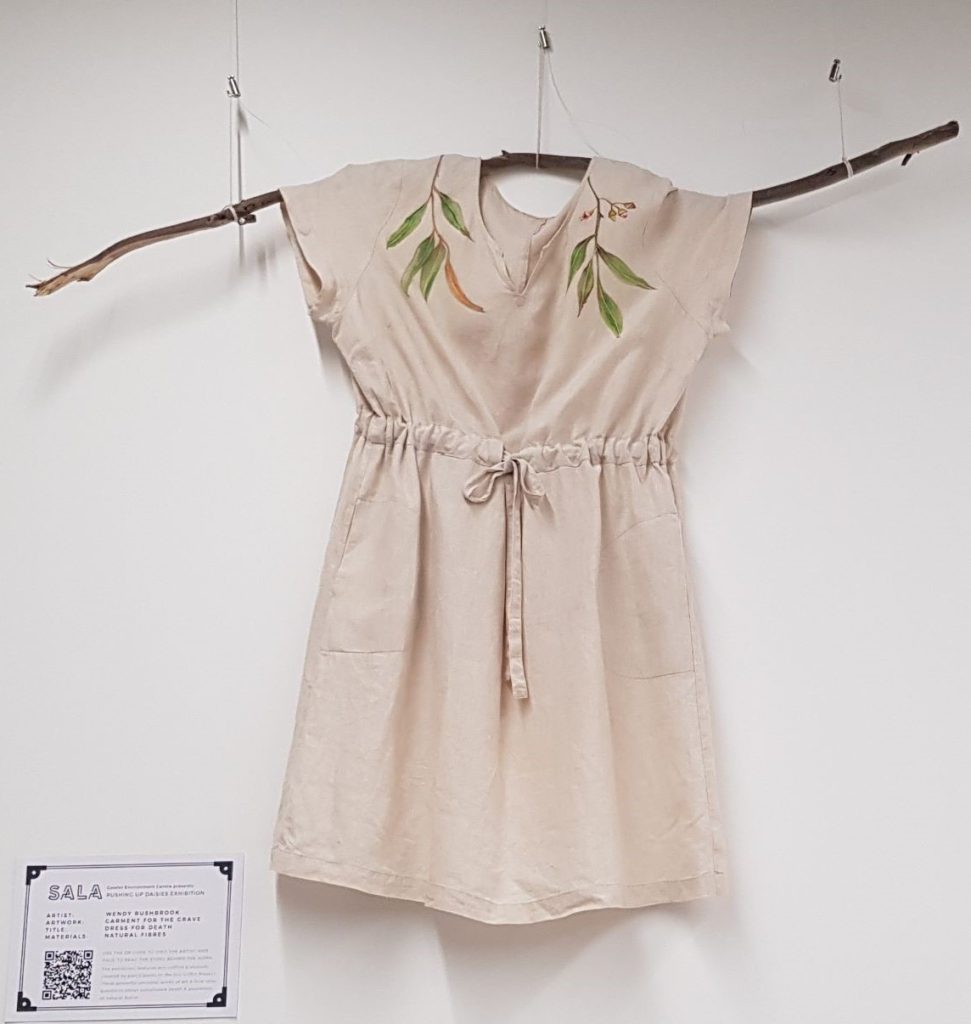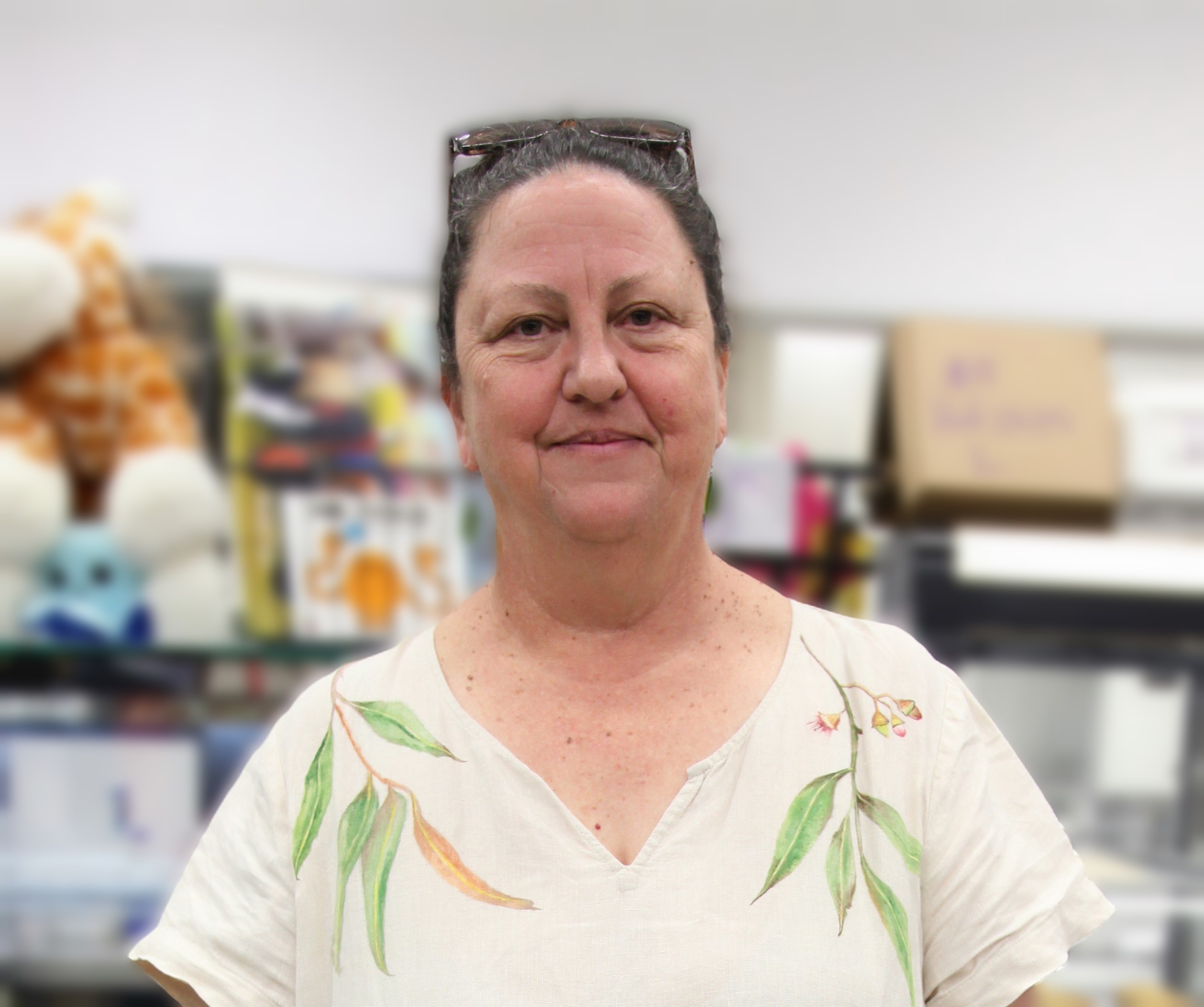
Artist: Wendy Rushbrook
Type: Death Dress
Title: Dress For Death
Materials: Cotton dress from op-shop, fabric paint
Why did you choose to work on a death dress rather than a coffin or shroud?
I try to live as lightly as possible so a shroud/dress involves the least amount of material of the two.
What materials have you used for your artwork?
I have used a linen dress bought for $4 at an op shop a few years ago just for my burial. Also some fabric paints I already had at home. Unfortunately not natural based paints but didn’t think that going out and buying them when I already had some was a good decision. Hopefully the amount of chemicals in these paints that ends up in the ground is negligible.
What is the story behind your artwork. What does it represent about you and your life story?
I have always loved eucalypts for their leaves and flowers – they are the epitome of the Australian environment. The dress represents simplicity and using what we have.
My journey to this exhibition has been varied and interesting! I have a passion for reusing items and can’t stand waste. I also have a passion for natural burial, so I couldn’t think of anything more relevant and exciting than being involved in this fabulous project. First I thought I’d make and decorate a cotton, silk or linen shroud for my natural burial. This entails being wrapped in a natural fabric that will decompose into the soil. No body embalming, no chemicals.
The best option would be something already used and local. The embodied energy in new items is not always considered in purchases. For example a few metres of cheap silk fabric from Asia has already had a lot of effort put into it – water and electricity from the factory, oil from the transport to Australia, Adelaide then to me. There’d be paper and plastics in the packaging, and someone being paid at every step of this transaction to get it here.
I then mulled over how I would decorate it and read many books on dyeing with leaves and flowers. I’d painted a picture on canvas once with pomegranate juice and that faded quite quickly, so pomegranate was out. Many mordants used to set the colours from plants are alum, chrome and other nasties, so they were out too. There are natural based, non-chemical fabric paints on the market so I earmarked them for later. My choices were narrowing, and I was thankful.
What part would I decorate? How can I avoid folds on the shroud (once I’m in it) interfering with the layout of the decoration? So I decided on a smaller, almost table-runner sized shroud cover. Like a pall covering a coffin. Then I would have a manageable piece of beautiful fabric I could use until my death as a tablecloth, or line it, applique and embroider it and use as a small quilt. I posted on Facebook, asked for plain, pale natural cotton, linen or raw silk fabric. I couldn’t get what I wanted, then I realised I still didn’t KNOW what I wanted. The silk felt too opulent, and having been to a silk farm I know what’s involved. A huge effort from both the silkworms and the human workers. It just didn’t feel right. Now silk was out of the equation.
So I thought laterally. As I have a permaculture background I identified what I have access to already. I live in the country and have many friends with sheep and alpaca wool. I’d already done some study on natural burial and saw beautiful felt pods made by a lady in Cornwall, UK – https://bellacouche.com/. I’d get some wool and work it into a pod to cover my body. Great! But then what do I do with it? I’m not planning to die yet. We have moths to contend with, and are in the middle of a mouse plague at the moment – and not the only one I’m assuming between now and my death. So the pod idea went out the window too.
This brought me full circle, and I was grateful for the learning of it all. I reflected on my values and the ethics of my day to day living. For this project I want:
- Natural material that’s second hand
- No manufactured embellishments
- Something that doesn’t have to travel a great distance
Then it hit me. Why not use the dress I am going to be buried in underneath the shroud. I bought it for $4 from a local op shop about 5 years ago specifically for my burial. A beige linen, shapeless dress perfect for the job. It doesn’t take up much space and can be worn between now and when it’s needed for its final outing.
I have worn it once. One of those really hot days around 45 degrees C. I wore it to work and my lovely colleagues were commenting on how nice it was. I tried not to smirk but couldn’t hold it in after a few comments. I explained that I was laughing because of the purpose of the dress, and I told them all the story. Everyone went quiet for a second, then my beautiful friend piped up “Well dear you shouldn’t be wearing it to school, you might get it dirty”. And we laughed and laughed.
What are 3 things you have learned from being part of the eco coffin project?
- Everyone has a story
- Homemade coffins and shrouds need to be taken to the funeral director beforehand to be tested for strength (obvious, but I’d never thought about it…)
- It’s possible to ask for cremated remains to be crushed less so the ashes are a little denser and go where they are thrown.
What is one thing you will do (or have done already) differently as a result from being part of the project?
I have changed my place of burial to Wirra Wonga natural burial ground at Enfield for two reasons:
- There is little chance of a dedicated natural burial area being established in my region and
- I feel I would have come ‘home’. I lived a few streets away from Enfield Cemetery for the first 23 years of my life, used to ride my bike through Folland Park and the pony club and jog to the cemetery with my dog to visit my dad who is buried there. It feels right.
Any other thoughts or comments you would like to add?
I was pleased to hear that metal fragments from cremated bodies are collected and sent away for recycling.


